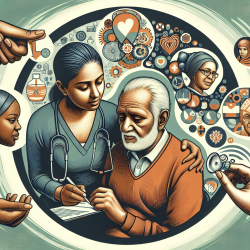Introduction
The COVID-19 pandemic has been a significant disruptor in many areas of life, particularly in the realm of adolescent physical activity and fitness. A recent study titled "Adolescents’ Behaviors, Fitness, and Knowledge Related to Active Living before and during the COVID-19 Pandemic: A Repeated Cross-Sectional Analysis" sheds light on how these disruptions have impacted adolescents' behaviors and fitness levels. As practitioners, understanding these findings can help us better support children's health and well-being as we navigate the post-pandemic world.
Key Findings from the Study
The study conducted a repeated cross-sectional analysis of adolescents' physical activity at school (PAS) and out-of-school (PAO), screen-based sedentary behaviors (SbSB), health-related fitness, and knowledge about physical activity and fitness. Data were collected at three different times: pre-pandemic (January 2020), during partial school reopening (February 2021), and full reopening (March 2021).
- Decrease in Out-of-School Physical Activity (PAO): The study found a significant decrease in PAO from pre-pandemic to partial reopening. This decline was consistent across weekdays and weekends, highlighting the pandemic's impact on adolescents' ability to engage in physical activities outside of school.
- Increase in Physical Activity at School (PAS): Interestingly, PAS increased during the partial reopening phase, suggesting that schools provided a critical environment for physical activity when other opportunities were limited.
- Reduction in Screen-Based Sedentary Behavior (SbSB): There was a notable decrease in SbSB from the partial to full reopening phase, indicating a positive shift as schools resumed regular operations.
- Improvement in Health-Related Fitness: Health-related fitness, particularly cardiorespiratory endurance and abdominal strength, improved from the partial to full reopening phase, possibly due to the implementation of a fitness education curriculum.
- Gender and Grade Differences: The study also highlighted differences in physical activity and fitness changes based on gender and grade, emphasizing the need for tailored interventions.
Implications for Practitioners
These findings offer valuable insights for practitioners working with adolescents. Here are some strategies to consider:
- Encourage School-Based Physical Activities: Schools play a crucial role in providing opportunities for physical activity. Encouraging schools to integrate more physical activities during the day can help mitigate the decline in out-of-school physical activity.
- Address Screen Time: With the reduction in SbSB during school reopening, practitioners should focus on strategies to maintain this trend, such as promoting outdoor activities and setting limits on screen time.
- Implement Fitness Education Programs: The improvement in health-related fitness suggests that structured fitness education programs can be effective. Practitioners should advocate for the inclusion of such programs in school curricula.
- Tailor Interventions Based on Demographics: Recognizing the differences in activity levels based on gender and grade, interventions should be customized to address the specific needs of different groups.
Conclusion
The COVID-19 pandemic has undeniably affected adolescents' physical activity and fitness levels. However, with targeted interventions and a focus on school-based activities, we can help mitigate these impacts and promote healthier lifestyles for our youth. For a more in-depth understanding of these findings, practitioners are encouraged to explore the full research paper.
To read the original research paper, please follow this link: Adolescents’ Behaviors, Fitness, and Knowledge Related to Active Living before and during the COVID-19 Pandemic: A Repeated Cross-Sectional Analysis.










